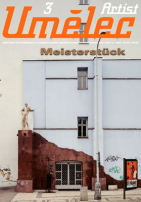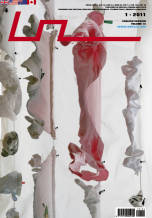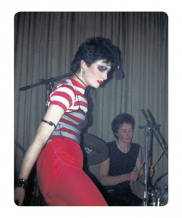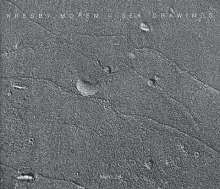| Umělec 1999/3 >> Of Curator Power (Interview with Fine Arts Academy student and occasional curator Milan Salák) | Просмотр всех номеров | ||||||||||||
|
|||||||||||||
Of Curator Power (Interview with Fine Arts Academy student and occasional curator Milan Salák)Umělec 1999/301.03.1999 Lenka Lindaurová a Vladan Šír | Of Curator Power | en cs |
|||||||||||||
|
"What drives to work as a curator in addition to making your own art?
The work of a curator is art also. Art is not finished at the moment when it strikes you. It is necessary to make it and then somebody has to see it, too. I cannot count on somebody coming up with the same idea that I have. Or if somebody does come up with the same idea, he or she doesn’t have to show my work [in such exhibition]. In case of the exhibitions we have done, the artifact is merely a construction element, it is not the reason and serves as a mere substitute element. It depends on the context which the art works are placed into. This is why curatorial work is important. So you became involved in it in order to exhibit yourself? When I think of something I am interested in and make art at the same time, it deals precisely with art and presentation of art is called exhibition. I am interested in group exhibitions: it’s sort of an aberration of mine. I’m not interested in solo exhibitions that much, especially those of my peers. I find the so-called mature artists and the ones that are even older mostly boring but they already have a right to some monographic senility. I am interested in exhibitions that are alive, that come to exist out of some feeling and have something to say. This is where I connect with my colleagues Jakub Dolejš and Honza Kadlec. Together we have initiated such exhibitions. Our first “curatorial“ show was Boystory. We were intrigued that a number of artists of our generation feel the need to show off those sentimental securities, the first sensations, references to the pristine, non-handicapped perception. There are a lot of those things around now but sometimes they follow a kind of pop-superficial line. It drives me crazy when somebody uses notions like Vinnetou in a way that the photograph of him is someone’s longtime and well preserved treasure and yet he lays it in wax in order to show that he realizes all the connections. This common nostalgia is not handled well at all. It drives me nuts when somebody is cooking according to this recipe and then does not eat it himself. I want to do it differently. It appears that you feel a need to define yourself against Mr. and Mrs. Ševčík’s group exhibitions. What is main contradiction in your approach and theirs? I wouldn’t call it contradiction because they included me in their bigger shows. What I see as a problem is their efforts to fill up Mánes Gallery because our [art] scene is not big enough for Mánes. In case of such large exhibitions, you can feel that there are things that just fill it up and those that got out of control. The Ševčíks try to find something that they feel exists in the world (I feel it too), they give it a name and they search for it also on the local art scene. Perhaps it’s an important job letting the world know that we have a clue. I’m not sure, however, whether it is correct to enounce a social exhibition and have the artists who thread beans or do other funny things face a challenge of making something social if they want to show in Mánes. Certainly, you can make commissioned artworks but their form should not be mistaken for content. The Ševčíks simply have a desire to find social traumas. That’s why the exhibitions always look like a bazaar. Their last exhibition at the Špálova Gallery seems quite nice to me - as a whole. There are, of course, some pieces of shit, too. Vargová, for example. The sensuality is such a cheap lure. Pink semi-shapes - that makes clear what it is. In other occasions, the Ševčíks see quite far ahead. Say, at the last Fine Arts Academy exhibition in Mánes, Mrs. Ševčíková came to us and said she would make a travel agency for us in the gallery’s glass-wall corner. What you can see on pages of Flash Arts now they were suggesting at that time already. I call it uncritical sociality. It wasn’t inherent in the things shown in Mánes precisely but it was the case of later exhibitions: Boystory was supposed to be about this as well. So what is the reason you feel the need to be a curator, what is your program? I don’t have any clear program in curating - like knowing what I want to get to. I enjoyed taking part in symposia, make a project for a specific situation. I just feel better if I direct some works at an exhibition project. The Sport Gallery exhibition came about in a way that people who were showing work there did not just deal with the topic by making the pieces but they were living it. Your activities, however, do not look like they lack an objective. Everybody has a clear objective - [Milan] Knížák has it, Olbram Zoubek as well. That is to be immortal and drive a Porsche. Everybody dreams about that while [Jan] Saudek, as stupid as he is, dares to talk about it. Making art is an easy formula for getting society’s respect, power and turning that into money. It has been like this in the past and the ones I spoke about did it as well. It’s all the same. My objective is not to provide space for the young upcoming generation, or at least not until the moment I start to feel the need. If I don’t die in a car accident like James Dean, I will be an individualist, like, say, [Jaroslav] Róna. If I don’t die in a car accident like Falco, I will perhaps speak of personal honesty like Šerých. I will be humble, even though everybody knows that faith is not painting a cross on a canvas and mysticism is not a skull made out of bronze. What was the meaning of the Green exhibition? We did this one just for the hell of it. The concept was created a year before the exhibition was realized. It took such a long time because the Academy’s committee couldn’t understand that I was not able to present them concrete picture for evaluation whether they are fit for exhibiting. They received a text but they could not picture it. I was inspired by situation when people argue to death about painting at symposium, whether curators have a right to interpret art or not, whether it is bad and whether it is the only possibility. From my perspective, it’s like this: by presenting it [in curated group shows], art is naturally placed into a context which is different from the one it was created in. When the artist made it, he was alone, wearing underwear, whereas at an opening, he is surrounded by tons of people and it’s completely different situation. It’s impossible to say that the curator is a Satan. It is true that it’s not good if an exhibition can be perceived as a whole and one cannot see the individual works. Was there also parody on curators’ exhibitions inherent in this show? Our aim was definitely not: “Wow, he got ‘em.“ The exhibition was aware of this, too, but there was a little bit of parody. It was the first time that I worked with artists as a curator. Curator has a lot of power, indeed. The greatest feeling was, though, that almost everybody was there since everybody sleeps with everybody in this art scene or they beat one another up. I like that. What else do you like? I don’t know, I’m more of an analytical type. Perhaps that is why I like things that I cannot fully understand. Right now, there is Martin Kuriš exhibition at the Academy. He interests me. He is obsessed with Romanticism: he wrote poetry and was so overwhelmed by Prague that he became addicted to drugs, he had to go for detox for a year... He makes strange paintings now, a bit Flemish with contemporary elements, lacking the sterilizing experience. Kuriš is a type of artist who would piss me off a lot a few years back. Some people naturally claim his work to be kitsch. Maybe he really got me, perhaps it’s just excellent. Now I like people who make similar paintings like Kuriš, although Knap, Trabura or the “Meisters“ from Beran’s studio are not my cup of tea really. Perhaps Kudrnáč of Střížek’s studio is making something similar but he’s completely crazy. I mean, I listen to Karel Gott, too, by he’s afraid of the day Gott dies. Aren’t you a bit conservative? Well, I’m 25 already. I don’t identify with these things, I find them fascinating. I’m interested in things that are on the verge of kitsch. I want to look at them. Their obsessiveness is frightening. Plus I’m controlling myself so that I don’t say something stupid here. At the end of last year, you were one of the founders of Artlab, an association that was getting ready to take over Nová Síň Gallery. The gallery has been closed for four months, though. What happened? Karel Babíček, the gallery’s former chief, was negotiating with us on the take-over of the space. He claimed that the ČFU Foundation, owner of the space, knows about us and that he is authorized to negotiate with us. We created a group of people - me, Kadlec, Jiří David, Martin Dostál and Milena Slavická - we approached sponsors and basically got everything ready for the gallery to be operational. Then it turned out that the Foundation did not know that Babíček is leaving and nothing about us either. Because of Babíček’s debts, the Foundation dismissed any further negotiations with us. Nová Síň is now going to show exhibitions that were planned for the Galerie Bratří Čapků. We may take part in tender for the space at the end of the year. We have already secured grants and sponsorship for some of the projects and we’ll try to find a new space. One of the projects should be War Worry exhibition. The biggest project we plan is an exhibition of Czech art of the 1990‘s. What should it include? The idea of this exhibition is a response to the challenge of other larger collective shows. The Ševčíks have also been involved mostly in the art of the 90‘s so you cannot go wrong in selecting people: this one and that one has to be there plus you add some alternatives. If Kintera of Dopitová are missing, there will be a question mark left. But I am interested in what we personally like. We don’t want to make the exhibition in a gallery space but there has to be some unifying interference. Architect Pleskot should be in charge of that. We told Milena Slavická about the project, we also addressed the Ševčíks because they have their big share on development of this period but they expressed unwillingness to take part in the project or perhaps they wanted someone else to break their necks. We have arrived at a certain concept: the exhibition should not be historically correct - that is not just insurance in case we forgot somebody but we’re interested in a certain moment. The 90‘s are typical for strong emphasis on concept and installation but with the 80‘s post-modern experience inherent in them. A concept is not perceived as clearly intellectual thing, it also contains even emotive elements and visual qualities. We made a selection of artists based on this line: we addressed also Kolíbal although he belongs to another category but it is interesting to place him into this context, then there will be Ivan Kafka, people from the Stubborn and the Monday groups. The show should not include the lyrical tendencies; installation is going to be predominant. But I don’t want to just show well-known works in a prestigious space, that wouldn’t satisfy me. Do you consider installation art a certain phenomenon of this period? We feel it like that. From global point of view, it is not the case. From that perspective it would have to be mostly installations but also some pictures. The good thing is we don’t have to include them. Into what extent was artist Jiří David involved in preparing this exhibition? He is important due to his authority. I was 17 in 1990 so I could make a lot of mis-judgements which could be cute but they would interfere with the context. David is one of the most experienced people. I’m honored that I’m on familiar terms with him. He wants to be the mover of the art scene and I feel something similar. But who are the true movers and shakers of the art scene in the end? The truth is that the public are somewhere else and the art scene is 90% composed of people who own the Ateliér magazine and if they freed themselves from personal things, there would be only 10% of what we are talking about. We’re going to be run over by those pseudo-heirs of Švabinský, Svolinský and Filla. There are more of them so they will own galleries like Mánes and Nová Síň. What can be done about that? I don’t believe in the culture’s self-cleaning abilities. Naturally, activity should come from various angels, things should be permanently talked about in media. Perhaps it will happen before such galleries as Mánes and Nová Síň are turned into garages of people selling trash on Charles Bridge and the Castle Stairs. "
01.03.1999
Рекомендуемые статьи
|
|||||||||||||
|
04.02.2020 10:17
Letošní 50. ročník Art Basel přilákal celkem 93 000 návštěvníků a sběratelů z 80 zemí světa. 290 prémiových galerií představilo umělecká díla od počátku 20. století až po současnost. Hlavní sektor přehlídky, tradičně v prvním patře výstavního prostoru, představil 232 předních galerií z celého světa nabízející umění nejvyšší kvality. Veletrh ukázal vzestupný trend prodeje prostřednictvím galerií jak soukromým sbírkám, tak i institucím. Kromě hlavního veletrhu stály za návštěvu i ty přidružené: Volta, Liste a Photo Basel, k tomu doprovodné programy a výstavy v místních institucích, které kvalitou daleko přesahují hranice města tj. Kunsthalle Basel, Kunstmuseum, Tinguely muzeum nebo Fondation Beyeler.
|






























 New book by I.M.Jirous in English at our online bookshop.
New book by I.M.Jirous in English at our online bookshop.
Комментарии
Статья не была прокомментированаДобавить новый комментарий